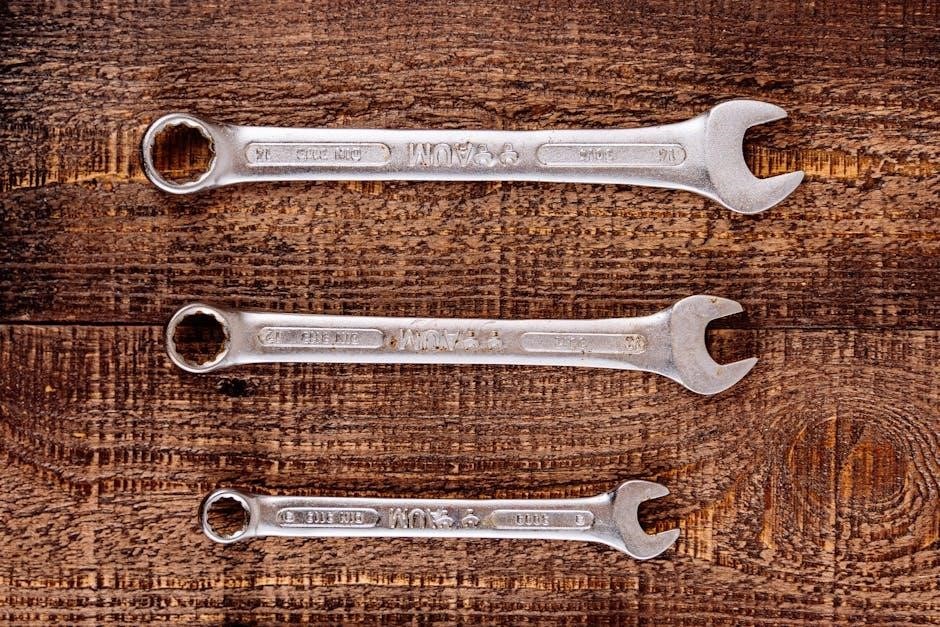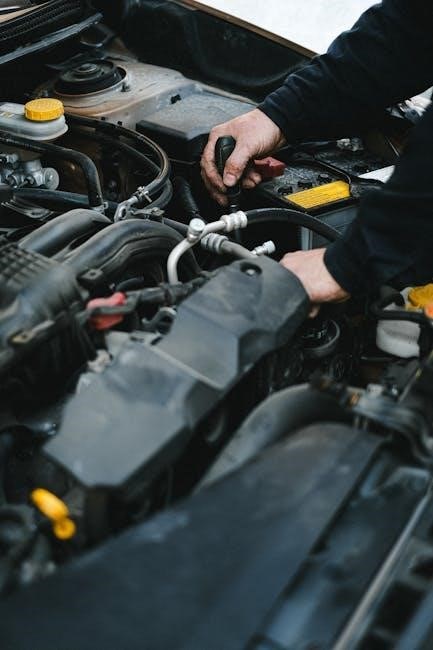The Peterbilt 579 Service Manual is a comprehensive guide providing detailed instructions for maintenance, repairs, and troubleshooting. It ensures optimal performance and reliability, catering to both professionals and DIY enthusiasts.
1.1 Overview of the Peterbilt 579
The Peterbilt 579 is a highly regarded on-highway truck known for its exceptional performance, efficiency, and driver comfort. Designed to meet the demands of long-haul trucking, it combines aerodynamic design with robust engineering. The 579 series is popular among professional drivers and fleets due to its reliability and versatility. It features a spacious and ergonomic cabin, offering a comfortable workspace for drivers on extended trips. The truck is powered by high-performance engines, including the PACCAR MX-13, and offers multiple transmission options to suit various operational needs. Its aerodynamic design reduces wind resistance, enhancing fuel efficiency and overall performance. The Peterbilt 579 is also equipped with advanced safety features, such as collision mitigation systems, to ensure driver and road safety. This model has become a benchmark in the trucking industry, balancing power, efficiency, and comfort seamlessly.
1.2 Importance of the Service Manual
The Peterbilt 579 service manual is an essential resource for owners, operators, and technicians, providing detailed guidance for maintenance, repair, and troubleshooting. It ensures that the truck operates at peak performance, extending its lifespan and preventing unexpected breakdowns. The manual contains critical information about diagnostic procedures, parts specifications, and repair techniques, helping users address issues efficiently. By following the manual’s instructions, drivers and mechanics can maintain safety standards, reduce operational costs, and ensure compliance with manufacturer recommendations. Regular reference to the service manual also helps in identifying potential problems early, minimizing downtime and optimizing overall efficiency. It is a vital tool for anyone involved in the upkeep and operation of the Peterbilt 579, ensuring reliability and adherence to warranty requirements.

Technical Specifications of the Peterbilt 579
The Peterbilt 579 features powerful engine options, advanced transmission systems, and optimized axle ratios for improved performance. Its robust suspension systems ensure a smooth ride, while its aerodynamic design enhances fuel efficiency.
2.1 Engine and Transmission Details
The Peterbilt 579 is equipped with a range of powerful engine options, including the PACCAR MX-13 and MX-11 engines, known for their reliability and performance. The MX-13 delivers up to 500 horsepower and 1,850 lb.-ft. of torque, while the MX-11 offers up to 430 horsepower and 1,550 lb.-ft. of torque. These engines are paired with advanced transmission systems, such as the Eaton Fuller UltraShift and Allison automatic transmissions, which provide smooth shifting and improved fuel efficiency. The manual also details the optional automated manual transmissions, designed for optimal performance in various driving conditions. With a focus on durability and efficiency, the Peterbilt 579’s engine and transmission combinations are tailored to meet the demands of long-haul trucking while minimizing maintenance needs. Proper servicing of these components, as outlined in the manual, ensures peak performance and extended lifespan. Regular checks and fluid replacements are emphasized to maintain optimal functionality.
2.2 Axle Ratios and Suspension Systems
The Peterbilt 579 features a variety of axle ratio options to optimize performance for different applications, ranging from 3.21 to 4.10. These ratios are designed to balance fuel efficiency, torque, and hauling capacity, ensuring the truck meets specific operational demands. The manual details the recommended axle ratios for various load conditions and driving environments. Additionally, the truck is equipped with advanced suspension systems, including air ride and taperleaf spring suspensions, which provide a smooth ride and improved stability. The air suspension system is particularly noted for its ability to adjust to varying payloads, enhancing comfort and reducing wear on components. Regular maintenance of suspension components, such as air bags and shocks, is emphasized to maintain optimal performance and safety. Proper axle alignment is also highlighted as a critical factor in preventing uneven tire wear and ensuring efficient operation.
2.3 Cabin and Interior Features
The Peterbilt 579 boasts a spacious and ergonomic cabin designed for driver comfort and productivity. The interior features premium materials, including soft-touch surfaces and durable upholstery, ensuring a refined driving environment. The dash layout is intuitive, with easy access to controls and gauges. The truck offers multiple cabin configurations, including a sleeper option, to accommodate long-haul needs. Advanced technology integrates seamlessly into the cabin, with a high-resolution digital dashboard and optional infotainment systems. Ample storage compartments and cup holders are strategically placed for convenience. The air-ride driver’s seat is fully adjustable, providing optimal support during long drives. The cabin also includes features like climate control, power windows, and LED lighting for enhanced visibility and comfort. These interior elements combine to create a driver-centric space that prioritizes both functionality and relaxation. Regular cleaning and maintenance of interior components are recommended to preserve the truck’s aesthetic and operational integrity.
2.4 Weight and Dimensions
The Peterbilt 579 is designed to balance power and efficiency, with a focus on weight distribution and dimensional accuracy. The gross vehicle weight rating (GVWR) typically ranges between 14,000 to 33,000 pounds, depending on the configuration. The axle ratings are carefully calibrated to ensure optimal load capacity, with front axles rated at 12,000 pounds and rear axles up to 40,000 pounds. The wheelbase options vary from 115 to 265 inches, accommodating different cab and sleeper configurations. The overall length, including the sleeper, can reach up to 244 inches, while the height is approximately 113 inches. These dimensions ensure maneuverability and stability, even in tight spaces. Proper weight distribution and adherence to dimensional specifications are critical for safety and compliance with regulations. Regular checks of weight and dimensions are recommended to maintain performance and legal standards.

2.5 Fuel Capacity and Efficiency
The Peterbilt 579 is equipped with fuel tanks that range in capacity from 50 to 150 gallons, depending on the configuration, ensuring extended range for long-haul operations. Its fuel efficiency is optimized through advanced engine technologies and aerodynamic design, achieving an average of 8 to 10 miles per gallon under normal operating conditions. Factors such as load weight, driving habits, and terrain can influence fuel economy. Regular maintenance, proper tire pressure, and adherence to recommended driving practices can enhance efficiency. The truck also features systems like predictive cruise control and automatic tire inflation, which contribute to better fuel management. Proper fuel capacity and efficiency are crucial for reducing operational costs and environmental impact. Always refer to the service manual for specific recommendations on maintaining optimal fuel performance for your Peterbilt 579.
2.6 Emission Standards and Compliance
The Peterbilt 579 is designed to meet stringent environmental regulations, ensuring compliance with EPA emission standards for heavy-duty trucks. It incorporates advanced emission control technologies, such as Selective Catalytic Reduction (SCR) systems and Diesel Particulate Filters (DPF), to minimize nitrogen oxides (NOx) and particulate matter emissions. These systems work in tandem with the engine to maintain performance while reducing environmental impact. Regular maintenance of emission-related components, as outlined in the service manual, is crucial to ensure ongoing compliance and optimal efficiency; Adhering to these guidelines not only helps reduce emissions but also supports long-term operational reliability. Proper monitoring and servicing of emission control systems are essential to avoid potential issues and maintain regulatory conformity. Always consult the service manual for specific procedures related to emission system maintenance and updates.

Routine Maintenance Procedures
Regular inspections and timely service ensure the Peterbilt 579 operates efficiently and safely. Follow the service manual for scheduled maintenance, fluid checks, and filter replacements to maintain performance and longevity.
3.1 Daily Pre-Trip Inspections
Daily pre-trip inspections are crucial for ensuring the Peterbilt 579 is roadworthy and safe to operate. Drivers should systematically check tires, brakes, lights, and fluid levels.
Start with the exterior: inspect tire pressure, tread depth, and look for signs of damage or wear. Ensure all exterior lights, including headlights, brake lights, and turn signals, are functioning properly.
Next, examine the brakes: check for wear on brake pads and drums, and ensure the parking brake is operational. Review fluid levels, including engine oil, coolant, transmission, and brake fluids, topping them off as needed.
Finally, perform an interior check: test the steering, clutch, and accelerator pedals for smooth operation. Ensure all gauges and warning lights are functioning, and the seat, mirrors, and seatbelts are properly adjusted.
These steps, outlined in the Peterbilt 579 service manual, help prevent breakdowns and ensure compliance with safety regulations. Regular inspections also contribute to fuel efficiency and overall vehicle performance.
3.2 Scheduled Maintenance Intervals
The Peterbilt 579 service manual outlines specific maintenance intervals to ensure optimal performance and longevity of the vehicle. Regular maintenance is critical for preventing unexpected breakdowns and reducing repair costs.
Oil changes are recommended every 25,000 to 50,000 miles, depending on driving conditions. Air filter replacements should occur every 15,000 to 30,000 miles, while fuel filters need to be replaced every 10,000 to 15,000 miles. Tire rotations should be performed every 10,000 miles to ensure even wear.
The manual also specifies intervals for inspecting and replacing brake components, such as pads and rotors, typically every 50,000 miles. Suspension and steering components should be checked every 12,500 miles to maintain stability and control.
Adhering to these schedules ensures the Peterbilt 579 operates efficiently, maintains fuel economy, and meets safety standards. Neglecting scheduled maintenance can lead to premature wear and costly repairs.
3.3 Tips for DIY Maintenance
Performing DIY maintenance on your Peterbilt 579 can save time and money, but it requires careful planning and attention to detail. Always start by gathering the necessary tools and referencing the service manual for specific instructions.
Begin with simple tasks like checking fluid levels, inspecting air filters, and monitoring tire pressure. These routine checks can prevent major issues down the road. For more complex tasks, such as replacing belts or hoses, ensure you have the correct replacement parts and follow the manual’s guidelines.

When working with electrical systems, use a multimeter to diagnose issues and avoid short circuits. Regularly cleaning connectors and terminals can improve system performance. Additionally, lubricate moving parts like door hinges and suspension components to maintain smooth operation.
Always prioritize safety, and if unsure about a procedure, consult a professional mechanic to avoid potential damage or safety risks.

Common Repairs and Troubleshooting
Common repairs involve diagnosing electrical faults and addressing fault codes. Troubleshooting steps include identifying symptoms, checking error codes, and testing components. Always refer to the service manual for guidance. If issues persist, consult a certified technician for professional assistance.
4.1 Electrical System Issues
The Peterbilt 579 often experiences electrical system issues, such as faulty wiring, blown fuses, or malfunctioning alternators. Drivers may notice dimming lights, slow crank, or dead batteries. Diagnosing these problems involves checking the battery voltage, inspecting wiring connections, and testing the alternator output. Common fixes include replacing blown fuses, cleaning corroded terminals, or installing a new alternator.
Persistent electrical faults may require advanced troubleshooting, such as scanning for error codes using diagnostic tools. If issues recur, it’s crucial to consult the service manual for detailed repair procedures or seek assistance from a certified technician. Regular maintenance, like inspecting wiring and connections, can prevent electrical system failures. Always ensure repairs are done safely to avoid further damage or safety hazards.
4.2 Common Fault Codes and Solutions
The Peterbilt 579 service manual PDF outlines common fault codes that may appear during operation. One of the most frequent codes is P0670, which indicates a fault in the exhaust gas recirculation (EGR) system. This can often be resolved by cleaning or replacing the EGR valve. Another common code is P0191, related to low fuel pressure. This issue may require checking the fuel lines for blockages or replacing the fuel pressure sensor.
- P0366: Crankshaft position sensor performance. Solutions include cleaning or replacing the sensor and checking wiring connections.
- SPN 4324: Faulty boost pressure sensor. This may involve recalibrating or replacing the sensor.
Always refer to the service manual for detailed diagnostic steps and ensure repairs are performed by certified technicians to maintain warranty compliance and safety standards.

Operators Manual Insights
The Peterbilt 579 service manual PDF provides essential insights for operators, detailing proper vehicle operation, safety guidelines, and maintenance tips. It ensures drivers understand the truck’s systems, improving performance and reducing breakdown risks.
5.1 Understanding the Operators Manual
The Operator’s Manual for the Peterbilt 579 is a comprehensive guide designed to help drivers understand and operate the vehicle effectively. It covers essential information about the truck’s features, controls, and systems. The manual is divided into sections, including safety precautions, instrument cluster details, and operational tips. Drivers can find explanations of dashboard indicators, steering wheel controls, and infotainment systems. It also includes guidelines for optimal driving practices to ensure safety and fuel efficiency. The manual emphasizes pre-trip checks and routine maintenance tasks to prolong the vehicle’s lifespan. Understanding the Operator’s Manual is crucial for both new and experienced drivers to maximize performance and compliance with regulations. It serves as a reference for troubleshooting common issues and ensures drivers are aware of the truck’s capabilities and limitations. Regular review of the manual helps drivers stay informed and confident on the road.
5.2 Key Features and Functions
The Peterbilt 579 service manual PDF is designed to provide operators with a comprehensive guide to understanding and utilizing their vehicle’s systems effectively. Key features include detailed diagrams and illustrations that simplify complex processes, ensuring that drivers can identify and address issues quickly. The manual also includes a section dedicated to customizable settings, allowing operators to tailor the truck’s performance to their specific needs. Additionally, it covers advanced monitoring systems, such as real-time diagnostic tools, which help in maintaining optimal vehicle health. The manual emphasizes safety protocols, outlining proper procedures for emergency situations and routine checks. By adhering to the guidelines provided, operators can ensure compliance with legal and environmental standards. Overall, the Peterbilt 579 service manual is an indispensable resource for maximizing efficiency, safety, and productivity on the road. Its user-friendly format makes it accessible to both experienced drivers and newcomers.

Legal and Safety Considerations
The Peterbilt 579 service manual emphasizes adherence to safety standards and legal compliance, ensuring safe operating practices and environmental regulation conformity. Following guidelines is crucial for operator protection and compliance.
6.1 Safety Precautions and Guidelines
Safety is paramount when working with the Peterbilt 579, as outlined in the service manual. Always wear personal protective equipment (PPE), including gloves, safety glasses, and a face mask, when performing repairs or maintenance. Ensure the vehicle is on level ground and apply the parking brake before starting any work. Disconnect the battery to prevent accidental startups, and use jack stands for added stability when lifting the truck.
- Avoid working near open flames or sparks, especially around fuel systems or batteries.
- Use only approved tools and equipment to prevent damage to components.
- Follow proper procedures for handling hazardous materials, such as coolant or brake fluid.
- Be cautious of high-pressure systems, such as air brakes or hydraulic lines.
Adhering to these guidelines ensures a safe working environment and prevents potential accidents. Always refer to the service manual for specific safety instructions related to your task.
6.2 Warranty Information and Support
The Peterbilt 579 service manual provides detailed information on warranty coverage, ensuring owners and operators understand their entitlements. The warranty typically covers parts and labor for a specified period or mileage, depending on the component. It’s essential to review the manual to identify what is included and what may void the warranty. Regular maintenance, as outlined in the service manual, is often a condition of warranty validity. For repairs or replacements under warranty, owners should contact authorized Peterbilt dealers or service centers. The manual also provides guidance on how to file warranty claims and the documentation required. Additionally, Peterbilt offers customer support through their website or dedicated hotline for any warranty-related inquiries. Always refer to the manual or contact official support for the most accurate and up-to-date warranty information;
6.3 Environmental Regulations Compliance
The Peterbilt 579 is designed to meet strict environmental regulations, ensuring minimal ecological impact while maintaining performance. The truck complies with EPA emissions standards, incorporating advanced technologies like selective catalytic reduction (SCR) to reduce nitrogen oxide (NOx) emissions. The engine is equipped with a diesel particulate filter (DPF) to minimize soot and particulate matter. Regular maintenance, as outlined in the service manual, is crucial to ensure emissions systems function correctly. Proper fuel usage and adherence to scheduled servicing help maintain fuel efficiency, reducing carbon emissions. Operators must follow guidelines for waste disposal and fluid management to prevent environmental contamination. Compliance with these regulations not only reduces the truck’s environmental footprint but also ensures adherence to legal requirements, avoiding potential penalties. Staying informed about updates to emissions standards and incorporating the latest technologies ensures ongoing compliance and sustainability.

Resources and Support
The Peterbilt 579 service manual PDF offers access to authorized dealers, online forums, and direct contact information for troubleshooting and maintenance assistance, ensuring comprehensive support for operators.
- Authorized dealers provide genuine parts and expert service.
- Online forums connect operators for shared knowledge and solutions.
- Contact information ensures direct access to Peterbilt support teams.
7.1 Authorized Dealers and Service Centers
For the Peterbilt 579, accessing authorized dealers and service centers is essential for ensuring proper maintenance and repairs. These centers are equipped with certified technicians who specialize in Peterbilt models, guaranteeing high-quality service. They use genuine parts and follow the guidelines outlined in the Peterbilt 579 Service Manual to maintain your truck’s performance and longevity.
Authorized dealers offer a wide range of services, from routine maintenance to complex repairs. They also provide diagnostic tools and software updates specific to the Peterbilt 579. To locate an authorized service center, visit the official Peterbilt website, which features a dealer locator tool.
These centers often have extended service hours and provide emergency support for Truckers. Contacting them directly through their listed phone numbers or emails can help you schedule appointments or request assistance. Always ensure to use authorized centers to validate warranties and maintain compliance with manufacturer standards.
7.2 Online Forums and Communities
Online forums and communities are invaluable resources for drivers and technicians working with the Peterbilt 579. Websites like the Peterbilt Forum, Trucker Forum, and Reddit communities dedicated to heavy-duty trucks provide platforms for discussing maintenance, repairs, and troubleshooting. These forums often include threads where users share their experiences with the Peterbilt 579, offering practical advice and solutions to common issues. Additionally, some groups specialize in service manual discussions, where members can ask questions or provide insights on specific procedures. Engaging with these communities can help operators stay updated on the latest technical developments and best practices. Many users also share downloadable resources, including service manual excerpts or supplementary guides. Participating in these forums fosters a sense of collaboration and ensures that drivers and technicians can address challenges effectively.

7.3 Contact Information for Assistance
For any inquiries or support related to the Peterbilt 579 service manual, owners and operators can reach out to the dedicated customer service team. The official Peterbilt website provides a comprehensive contact section with toll-free numbers, email addresses, and a live chat feature. Additionally, authorized dealerships can be contacted directly for personalized assistance. For urgent matters, the 24/7 roadside assistance hotline is available to ensure minimal downtime. Users can also submit queries through the online support portal, which typically receives a response within 24 hours. The Peterbilt customer service team is committed to providing timely and effective solutions to keep your truck operational and efficient. Visit the official website or refer to the contact details in the service manual for more information.
